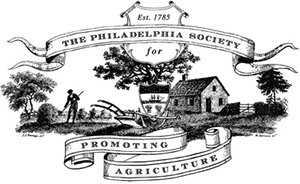PHILADELPHIA — When the Cumberland Valley School Board began proceedings in March to take a preserved farm by eminent domain, one of the factors working against preservationists was the farm’s isolation.
Over the years, suburbia had grown up around the 108 acres of open land on Harrisburg’s West Shore, and the farm was now hemmed in by shopping centers and car dealerships along a major highway.
In short, even though the farm was preserved, it remained vulnerable to development pressure.
Land use professor Tom Daniels doesn’t want preserved farms to end up as islands in a sea of asphalt.
He’d rather see them grouped together in large, contiguous blocks that allow farming to thrive.
“It keeps conflicting land uses at bay,” said Daniels, director of the land use and environmental planning concentration at the University of Pennsylvania.
Daniels spoke to the Philadelphia Society for Promoting Agriculture on Nov. 1 at the Union League of Philadelphia.
Determining which farms get preserved involves both strategy and opportunism.
Government agencies and private land trusts can pick out which farms they’d like to protect based on soil quality or farm size, but in the end they have to choose among the willing participants.
As a result, preservation entities generally use a point system to rank applicants.
Pennsylvania mandates that 40 percent of the points be allocated to soil quality.
Daniels, who’d rather see greater emphasis on proximity to other preserved farms, thinks the number for soil quality might be a little high for southeastern Pennsylvania, where good soils abound.
“The soil isn’t going to be a real discriminating factor,” he said.
Point systems generally favor large farms over small ones, but they can be adjusted based on the group’s land use priorities.
Preserving farms near developed areas, for example, could draw a line in the sand against further development, while preserving farms far from town could make preservation dollars go further.
Evaluators may even consider the permissiveness of the zoning on adjacent farms.
Occasionally developers have bought these next-door properties and used the preserved farm view as a selling point for the new houses, Daniels said.
Daniels prefers that preserved farms be grouped in blocks of at least 500 acres.
“It give farms some sense of certainty in their operations that they can invest in a chicken operation, they can put up a new dairy barn, and they’re not going to have neighbors complaining about their operations and trying to take them to court,” Daniels said.
Lancaster County — home to the most preserved farmland of any county in the U.S. — still has a fair amount of preserved land in scattered parcels.
But it has also created some large, contiguous blocks.
The number of preserved farmland blocks larger than 1,000 acres increased from nine in 2007 to 17 in 2016. One of those blocks includes 10,000 contiguous acres.
This success is notable because Lancaster is both one of the most productive farm counties in the East and among the most populous counties in the United States.
Daniels’ ideal of keeping preserved farms together works on a regional level as well.
Five big ag counties in southeastern Pennsylvania, including Lancaster, and another five in central Maryland have preserved a total of 600,000 acres.
That’s one-tenth of the preserved ag land in the whole country.
Add in New Jersey, Delaware and Maryland’s Eastern Shore, and this section of the Mid-Atlantic has more than 1 million acres of preserved farmland.
“This is really the heartland of farmland preservation,” Daniels said.
Almost all of these easements are perpetual, and they are much harder to overturn than agricultural zoning designations.
“Zoning is basically a political land use tool. It can change as the township supervisors change,” Daniels said.
Only a dozen easements have been overturned in court out of more than 100,000 nationwide, though that track record hasn’t always stopped people from challenging easements.
In the Cumberland Valley case, the school board, seeking land for a new school, targeted a preserved farm that was in a particularly vulnerable situation.
The farm was surrounded by development instead of other preserved farms, and it had plenty of tantalizing road frontage. The easement for the land had been donated to a private land trust, not purchased according to a strategy of preserving land in large blocks.
District residents objected to the taking of a preserved farm, but the school board only dropped its plan after the Legislature tightened the rules for seizing preserved land.
Lawmakers should know how strong public support is for farmland preservation.
In recent lean years, Daniels said, they’ve proposed raiding the state’s farm preservation account — it’s funded by a 2-cents-per-pack tax on cigarettes — but ended up bowing to constituent outcry.
Efforts to maintain an area’s farming industry may prosper most when farmland preservation is paired with other strategies.
Lancaster County heavily employs agricultural zoning and is the only county in the state using urban growth areas, Daniels said.
The latter technique, which has succeeded on the West Coast, sets limits on water and sewer lines to channel population growth in compact areas.
Through farmland preservation and support from both the government and private sector, “we’re going to have an agricultural industry in this part of the world for many, many years to come,” Daniels said.
Lancaster Farming, Philip Gruber, Nov 9, 2018

